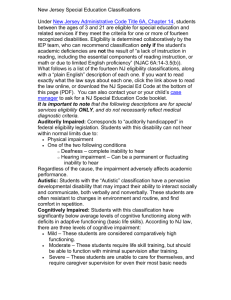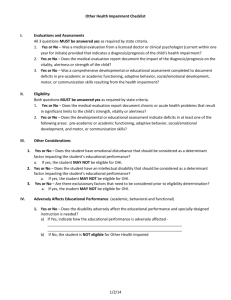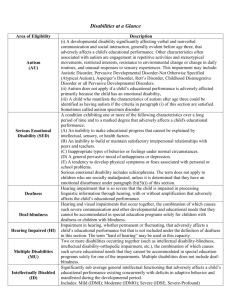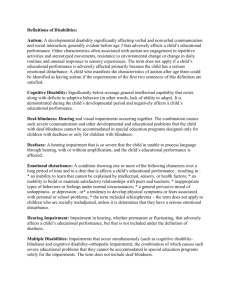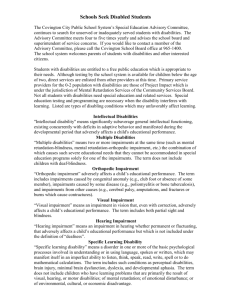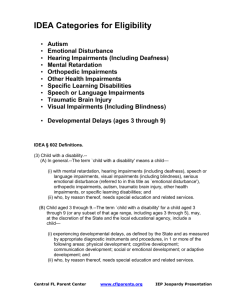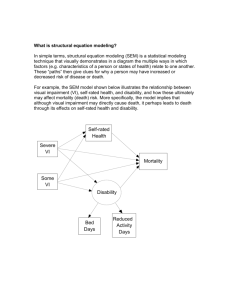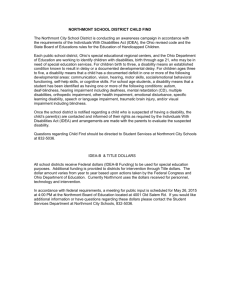ACPA 2014 Overview of Disability Types SCREEN READER
advertisement
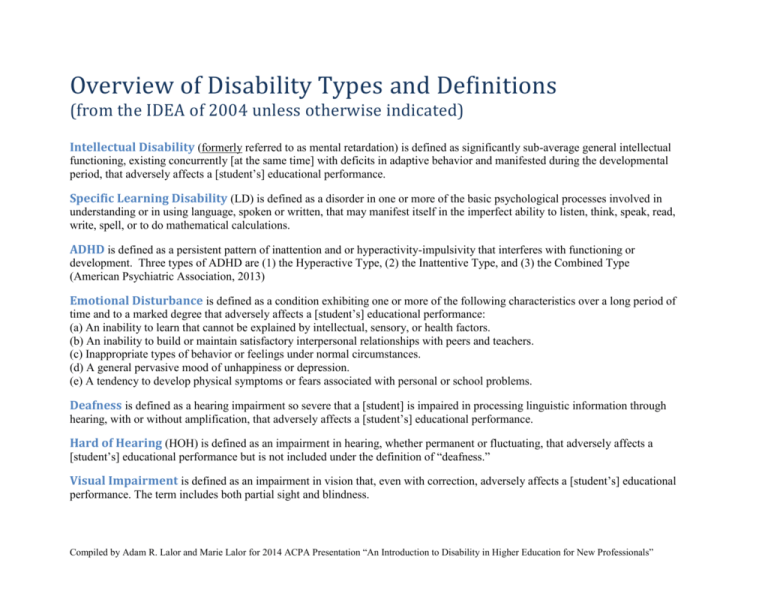
Overview of Disability Types and Definitions (from the IDEA of 2004 unless otherwise indicated) Intellectual Disability (formerly referred to as mental retardation) is defined as significantly sub-average general intellectual functioning, existing concurrently [at the same time] with deficits in adaptive behavior and manifested during the developmental period, that adversely affects a [student’s] educational performance. Specific Learning Disability (LD) is defined as a disorder in one or more of the basic psychological processes involved in understanding or in using language, spoken or written, that may manifest itself in the imperfect ability to listen, think, speak, read, write, spell, or to do mathematical calculations. ADHD is defined as a persistent pattern of inattention and or hyperactivity-impulsivity that interferes with functioning or development. Three types of ADHD are (1) the Hyperactive Type, (2) the Inattentive Type, and (3) the Combined Type (American Psychiatric Association, 2013) Emotional Disturbance is defined as a condition exhibiting one or more of the following characteristics over a long period of time and to a marked degree that adversely affects a [student’s] educational performance: (a) An inability to learn that cannot be explained by intellectual, sensory, or health factors. (b) An inability to build or maintain satisfactory interpersonal relationships with peers and teachers. (c) Inappropriate types of behavior or feelings under normal circumstances. (d) A general pervasive mood of unhappiness or depression. (e) A tendency to develop physical symptoms or fears associated with personal or school problems. Deafness is defined as a hearing impairment so severe that a [student] is impaired in processing linguistic information through hearing, with or without amplification, that adversely affects a [student’s] educational performance. Hard of Hearing (HOH) is defined as an impairment in hearing, whether permanent or fluctuating, that adversely affects a [student’s] educational performance but is not included under the definition of “deafness.” Visual Impairment is defined as an impairment in vision that, even with correction, adversely affects a [student’s] educational performance. The term includes both partial sight and blindness. Compiled by Adam R. Lalor and Marie Lalor for 2014 ACPA Presentation “An Introduction to Disability in Higher Education for New Professionals” Autism Spectrum Disorders (ASD) are defined as a developmental disability significantly affecting verbal and nonverbal communication and social interaction, generally evident before age three, that adversely affects a [student’s] educational performance. Other characteristics often associated with autism are engaging in repetitive activities and stereotyped movements, resistance to environmental change or change in daily routines, and unusual responses to sensory experiences. Traumatic Brain Injury (TBI) is defined as an acquired injury to the brain caused by an external physical force, resulting in total or partial functional disability or psychosocial impairment, or both, that adversely affects a [student’s] educational performance. The term applies to open or closed head injuries resulting in impairments in one or more areas, such as cognition; language; memory; attention; reasoning; abstract thinking; judgment; problem-solving; sensory, perceptual, and motor abilities; psychosocial behavior; physical functions; information processing; and speech. Physical/Orthopedic Disability is defined as a severe orthopedic impairment that adversely affects a [student’s] educational performance. The term includes impairments caused by a congenital anomaly, impairments caused by disease (e.g., poliomyelitis, bone tuberculosis), and impairments from other causes (e.g., cerebral palsy, amputations, and fractures or burns that cause contractures). Other Health Impairment is defined as having limited strength, vitality, or alertness, including a heightened alertness to environmental stimuli, that results in limited alertness with respect to the educational environment… due to chronic or acute health problems…and that adversely affects a [student’s] educational performance Psychiatric Disability is defined as a syndrome characterized by clinically significant disturbance in an individual's cognition, emotion regulation, or behavior that reflects a dysfunction in the psychological, biological, or developmental processes underlying mental functioning. (American Psychiatric Association, 2013) References American Psychiatric Association. (2013). Diagnostic and statistical manual of mental disorders (5th ed.). Arlington, VA: American Psychiatric Publishing. Individuals with Disabilities Education Act, 20 U.S.C. § 1400 (2004). Compiled by Adam R. Lalor and Marie Lalor for 2014 ACPA Presentation “An Introduction to Disability in Higher Education for New Professionals”

